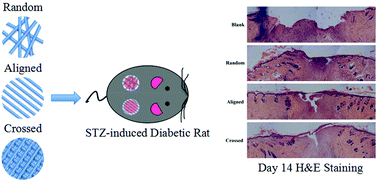当前位置:
X-MOL 学术
›
Biomater. Sci.
›
论文详情
Our official English website, www.x-mol.net, welcomes your feedback! (Note: you will need to create a separate account there.)
Enhanced wound healing in diabetic rats by nanofibrous scaffolds mimicking the basketweave pattern of collagen fibrils in native skin
Biomaterials Science ( IF 6.6 ) Pub Date : 2017-12-21 00:00:00 , DOI: 10.1039/c7bm00545h Luyao Sun 1, 2, 3, 4, 5 , Wendong Gao 1, 2, 3, 4, 5 , Xiaoling Fu 1, 2, 3, 4, 5 , Miao Shi 2, 3, 4, 5, 6 , Weihan Xie 1, 2, 3, 4, 5 , Wen Zhang 1, 2, 3, 4, 5 , Fujian Zhao 1, 2, 3, 4, 5 , Xiaofeng Chen 1, 2, 3, 4, 5
Biomaterials Science ( IF 6.6 ) Pub Date : 2017-12-21 00:00:00 , DOI: 10.1039/c7bm00545h Luyao Sun 1, 2, 3, 4, 5 , Wendong Gao 1, 2, 3, 4, 5 , Xiaoling Fu 1, 2, 3, 4, 5 , Miao Shi 2, 3, 4, 5, 6 , Weihan Xie 1, 2, 3, 4, 5 , Wen Zhang 1, 2, 3, 4, 5 , Fujian Zhao 1, 2, 3, 4, 5 , Xiaofeng Chen 1, 2, 3, 4, 5
Affiliation

|
Nanofibrous scaffolds that offer proper microenvironmental cues to promote the healing process are highly desirable for patients with chronic wounds. Although studies have shown that fiber organization regulates cell behaviors in vitro, little is known about its effects on the wound healing process in vivo. Most of the nanofibrous scaffolds currently used in skin repair are randomly oriented. Herein, inspired by the basketweave-like pattern of collagen fibrils in native skin, we fabricated biomimetic nanofibrous scaffolds with crossed fiber organization via electrospinning. The regulation of crossed nanofibrous scaffolds on fibroblasts was compared with that of aligned and random nanofibrous scaffolds. Unexpectedly, crossed nanofibrous scaffolds induced different cellular responses in fibroblasts, including differences in cellular morphology, migration and wound healing related gene expression, in comparison to either aligned or random nanofibrous scaffolds. More importantly, the regulation of nanofibrous scaffolds with different fiber organizations on wound repair was systematically investigated in diabetic rats. While the healing processes were enhanced by all nanofibrous scaffolds, wounds treated with crossed nanofibrous scaffolds achieved the best healing outcome, which was evidenced by the resolution of inflammation, the accelerated migration of fibroblasts and keratinocytes, and the promotion of angiogenesis. These findings helped reveal the role of fiber organization in regulating the wound healing process in vivo and suggest the potential utility of biomimetic crossed nanofibrous scaffolds for the repair of chronic wounds.
中文翻译:

纳米纤维支架模仿天然皮肤胶原蛋白原纤维的篮状结构,从而增强糖尿病大鼠的伤口愈合
提供合适的微环境线索以促进愈合过程的纳米纤维支架对于患有慢性伤口的患者是非常需要的。尽管研究表明纤维组织在体外调节细胞行为,但对其在体内伤口愈合过程中的作用知之甚少。当前用于皮肤修复的大多数纳米纤维支架是随机取向的。在此,受天然皮肤中胶原蛋白原纤维的篮状编织图案的启发,我们制造了具有交叉纤维组织的仿生纳米纤维支架,方法是通过静电纺丝。将交叉的纳米纤维支架对成纤维细胞的调节与对准的和随机的纳米纤维支架的调节进行了比较。出乎意料的是,与对齐的或随机的纳米纤维支架相比,交叉的纳米纤维支架在成纤维细胞中诱导了不同的细胞反应,包括细胞形态,迁移和伤口愈合相关基因表达的差异。更重要的是,在糖尿病大鼠中系统地研究了具有不同纤维组织的纳米纤维支架对伤口修复的调节作用。虽然所有纳米纤维支架均能促进愈合过程,但交叉纳米纤维支架治疗的伤口获得了最佳的愈合结果,这可以通过炎症的消退,成纤维细胞和角质形成细胞的加速迁移来证明,和促进血管生成。这些发现有助于揭示纤维组织在调节伤口愈合过程中的作用。在体内,并提出了仿生交叉纳米纤维支架在修复慢性伤口方面的潜在用途。
更新日期:2017-12-21
中文翻译:

纳米纤维支架模仿天然皮肤胶原蛋白原纤维的篮状结构,从而增强糖尿病大鼠的伤口愈合
提供合适的微环境线索以促进愈合过程的纳米纤维支架对于患有慢性伤口的患者是非常需要的。尽管研究表明纤维组织在体外调节细胞行为,但对其在体内伤口愈合过程中的作用知之甚少。当前用于皮肤修复的大多数纳米纤维支架是随机取向的。在此,受天然皮肤中胶原蛋白原纤维的篮状编织图案的启发,我们制造了具有交叉纤维组织的仿生纳米纤维支架,方法是通过静电纺丝。将交叉的纳米纤维支架对成纤维细胞的调节与对准的和随机的纳米纤维支架的调节进行了比较。出乎意料的是,与对齐的或随机的纳米纤维支架相比,交叉的纳米纤维支架在成纤维细胞中诱导了不同的细胞反应,包括细胞形态,迁移和伤口愈合相关基因表达的差异。更重要的是,在糖尿病大鼠中系统地研究了具有不同纤维组织的纳米纤维支架对伤口修复的调节作用。虽然所有纳米纤维支架均能促进愈合过程,但交叉纳米纤维支架治疗的伤口获得了最佳的愈合结果,这可以通过炎症的消退,成纤维细胞和角质形成细胞的加速迁移来证明,和促进血管生成。这些发现有助于揭示纤维组织在调节伤口愈合过程中的作用。在体内,并提出了仿生交叉纳米纤维支架在修复慢性伤口方面的潜在用途。



























 京公网安备 11010802027423号
京公网安备 11010802027423号